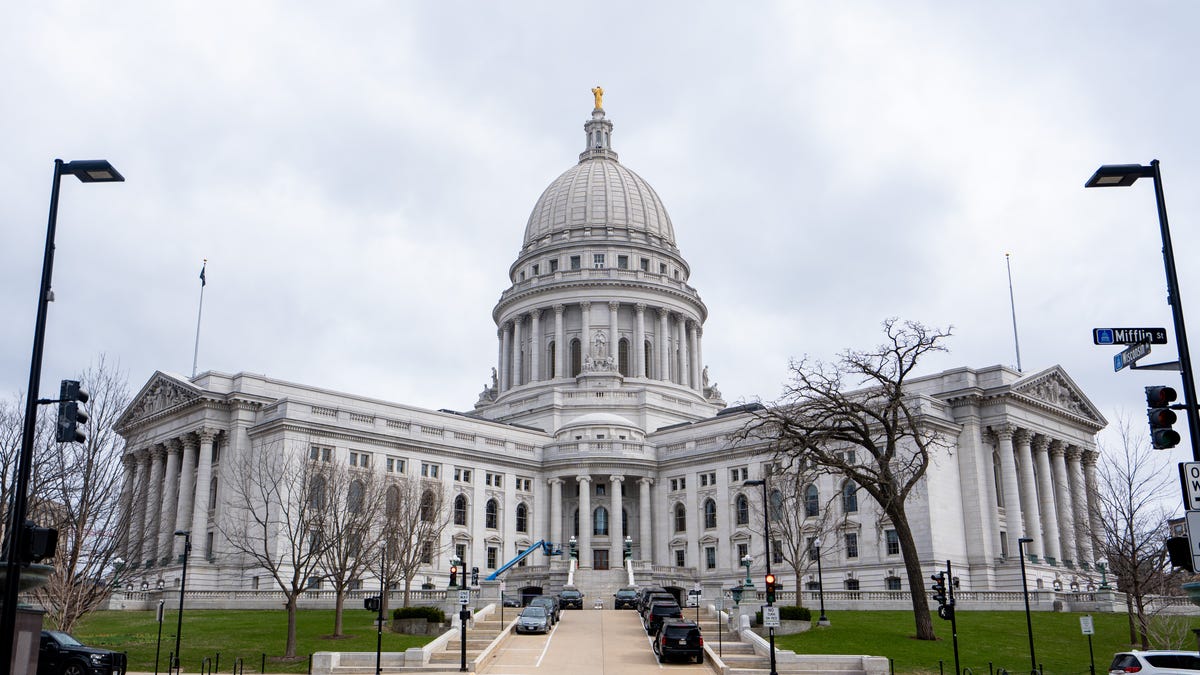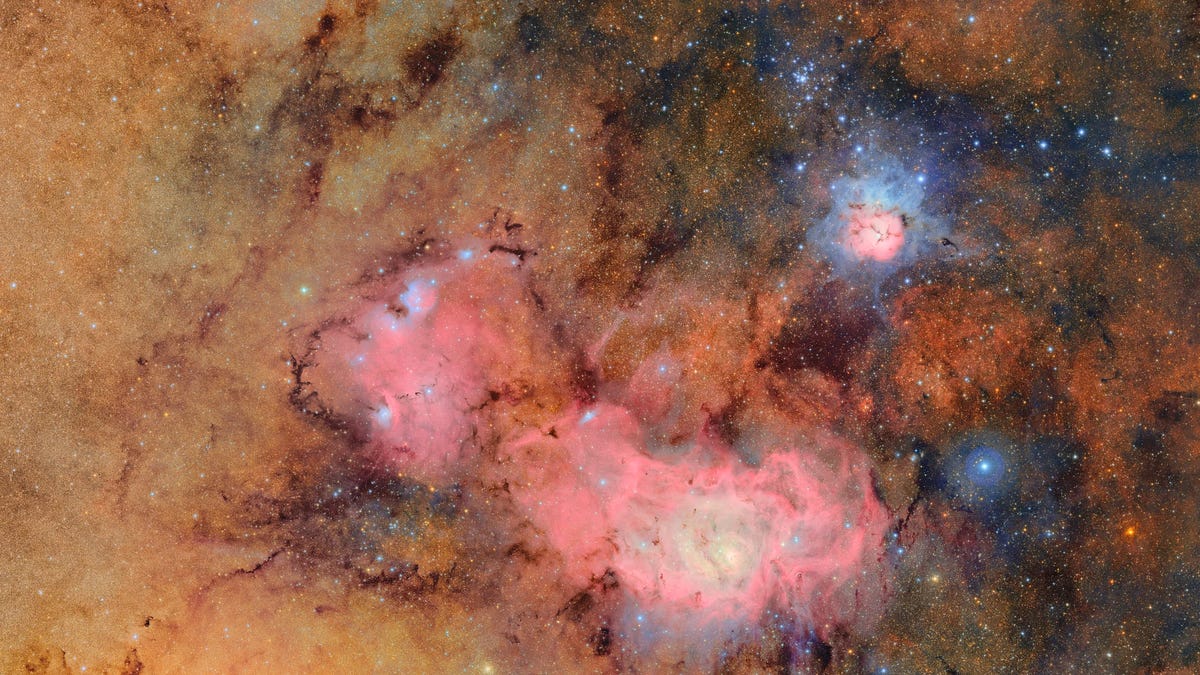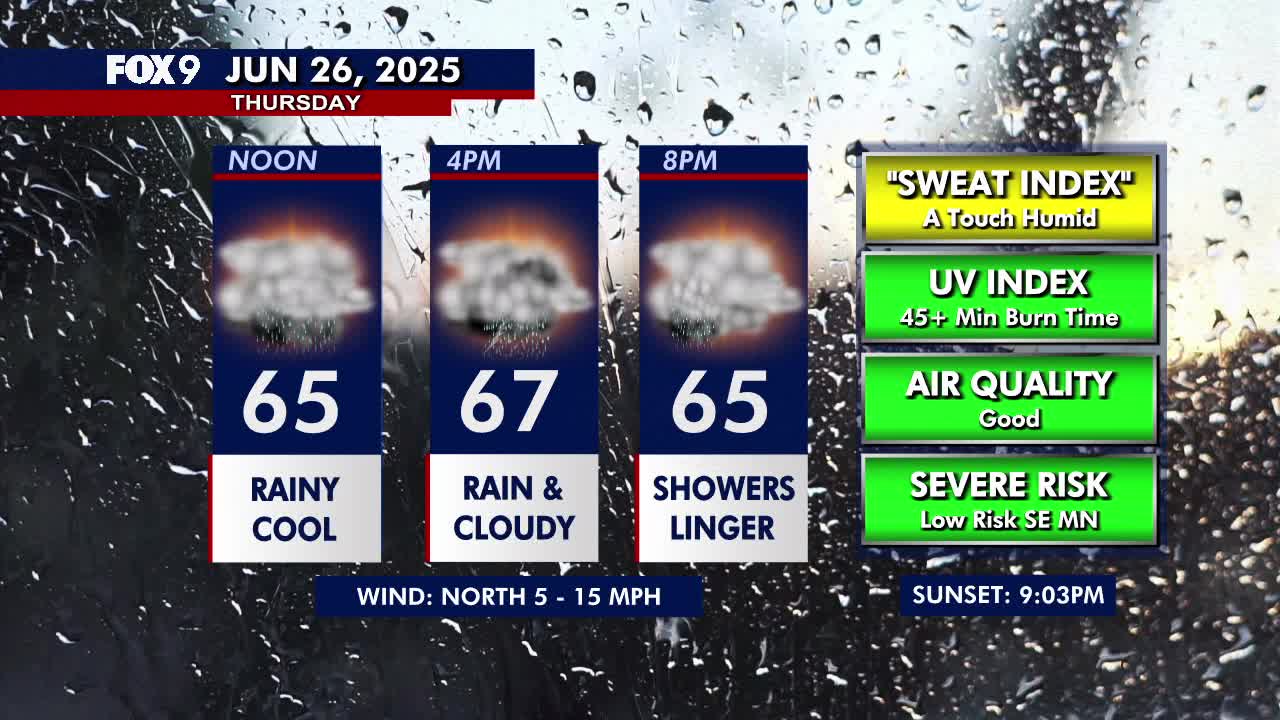Wisconsin
Illinois weather could be an additional challenge for Wisconsin football on Saturday. Find out why in Matt Holiner’s forecast

{{format_dollars}}
{{start_price}}
{{format_cents}}
{{promotional_format_dollars}}
{{promotional_price}}
{{promotional_format_cents}}
{{term}}
(renews at {{format_dollars}}{{start_price}}{{format_cents}}/month + tax)
{{action_button}}

Wisconsin
Wisconsin Lutheran High School crowd buzzing as Knueppel drafted by Charlotte

MILWAUKEE — Wisconsin native Kon Knueppel made history Wednesday night when the Charlotte Hornets selected him in the NBA draft, making him the highest draft pick ever from the state.
The former Wisconsin Lutheran High School star left an impressive legacy before moving on to Duke University and now the NBA.
Previous Coverage: Kon Knueppel is 4th overall NBA draft pick
Less than two years ago, he was celebrating a state championship with the Vikings.
At Wisconsin Lutheran High School Wednesday, friends, coaches, fans, and supporters gathered together for an NBA Draft Watch Party.
Former teammate Josiah Rice remembers Knueppel’s dedication during their time together.
Watch: Wisconsin Lutheran High School crowd buzzing as Knueppel drafted by Charlotte
Wisconsin Lutheran High School crowd buzzing as Knueppel drafted by Charlotte
“He was a very normal guy, but everything he did, he did hard. He was a hard worker. He was always in the gym coaching us too, just being a great teammate and all that,” Rice said.
Rice played alongside Knueppel in 2024 when the Vikings completed a perfect 30-0 season.
“It was just super fun to watch him play a lot of stuff. Great shooter, very athletic, surprisingly, but it was just super cool to see him on the court, and also for how he carries himself and stuff like that,” Rice said.
Mike Beiermeister
Knueppel’s senior year was filled with accolades. He led Wisconsin Lutheran to a state championship and was named Mr. Basketball for Wisconsin before heading to Duke University, where he helped the Blue Devils reach the Final Four.
His high school coach Ryan Walz expressed immense pride in Knueppel’s achievement.
“We’ve never had a kid ever be drafted before so I’m just — so much gratitude right now for being here and being able to share this moment with a lot of people who love Kon,” Walz said.

Mike Beiermeister
Tyson, a rising sophomore at Wisconsin Lutheran, looks up to Knueppel as a role model.
“He’s just, like, so strong, like, I can apply that to baseball, which I really like, and just keep working do the little things, right,” Tyson said.

Mike Beiermeister
The impact of Knueppel’s journey from high school standout to NBA draft pick has inspired many in the community.
“It’s actually pretty fun to see what God has given Kon of his abilities, you know, just to see him, like, go from all the way from freshman to senior, and then go to Duke. It’s pretty cool,” another student said.
During the draft watch event, Knueppel and his parents shared a special video message with the Wisconsin Lutheran community. He and his family were in New York for the draft.
“I really appreciate all of you being here and supporting me on this journey,” Knueppel told the gathered crowd.
Knueppel surpassed Wauwatosa East and Wisconsin Badgers star Devin Harris as the highest draft pick from Wisconsin. Harris was taken fifth in 2004 NBA Draft.
This story was reported on-air by Mike Beiermeister and has been converted to this platform with the assistance of AI. Our editorial team verifies all reporting on all platforms for fairness and accuracy.
Let’s talk:
Hey there! At TMJ4 News, we’re all about listening to our audience and tackling the stuff that really matters to you. Got a story idea, tip, or just want to chat about this piece? Hit us up using the form below. For more ways to get in touch, head over to tmj4.com/tips.
It’s about time to watch on your time. Stream local news and weather 24/7 by searching for “TMJ4” on your device.
Available for download on Roku, Apple TV, Amazon Fire TV, and more.
Report a typo or error // Submit a news tip
Wisconsin
Penalties for juror battery, help for Alzheimer’s caregivers. Here are bills that passed the Assembly

Alzheimer’s numbers expected to hit 13 million by 2050
Dr. Joanne Pike, CEO of the Alzheimer’s Association, talks about the challenges and hopes when it comes to this debilitating disease.
- The Wisconsin State Assembly passed several bills, including increased penalties for threats against jurors and changes to campground trespass laws.
- One bill removes the income cap for families seeking assistance through the Alzheimer’s Family and Caregiver Support Program.
- Debate continues among lawmakers regarding tying funding to proposed bills.
MADISON – The Wisconsin State Assembly passed a line up of bills on June 24 as lawmakers continue to argue about whether funding should be attached to proposed bills.
Here are some of the bills the Assembly took up.
Penalty for battery or threat to jurors
Passed by voice vote, this bipartisan bill would increase the penalty for battery or threat to jurors and their family members.
Under the bill, such actions would be made a Class H felony, allowing judges to prohibit convicted individuals from contacting jurors involved in their cases during their sentence or probation.
Bill co-author Rep. Shae Sortwell, R-Two Rivers, said on the Assembly floor that this bill ensures jurors will not be tampered with so that they can “decide the cases on its merits and not because of threats.”
Rep. Ryan Clancy, D-Milwaukee, argued that it’s already a crime to threaten battery and a penalty enhancer to an existing crime is “empty messaging.”
“Incarceration has become this Legislature’s default response… Locking more people up, for more crimes and more years does not keep us safe,” Clancy said during the June 24 floor session.
The bill passed in a 28-4 Senate vote on June 18, and is now on its way to the governor’s desk.
Criminal trespass at campgrounds
Passed by voice vote, this bill clarifies private campgrounds are not residences, and therefore guests can be evicted from the property and are not subject to landlord-tenant laws.
Under the bill, campground owners would be allowed to issue written requests to campers to vacate the property, with a list of reasons they are being asked to leave included. The owner of the campground must provide a refund for any payment covering the duration of the stay past the time campers leave.
If guests do not leave promptly after a written request is issued, they may be fined up to $100 or put into county jail for up to 30 days.
Clancy said that this bill “kicks people when they are down.”
“This legislation fails to differentiate between somebody who is trespassing at a party in a campground and someone who’s lived there for weeks, months or years because they have no other housing,” Clancy said on the Assembly floor.
The bill passed in the Senate by voice vote on June 18, and is now on its way to the governor’s desk.
Alzheimer’s family and caregiver support program
In a voice vote, the Assembly passed a bipartisan bill that would repeal the current financial eligibility requirement for services for families caring for someone with Alzheimer’s disease.
The bill would remove the current income cap set at $48,000 so more individuals with Alzheimer’s disease would be eligible for assistance from local agencies.
“These families need a lot of support… This bill will help those and many of us who have seen the effects of Alzheimer’s has had on a lot of our family and friends,” bill co-author Rep. Dean Kaufert, R-Neenah, said on the Assembly floor, adding that there have been leftover funds in the last few years and that it is important to get that money out to families who need it.
The Legislature created the Wisconsin’s Alzheimer’s Family and Caregiver Support Program was created in 1985 in response to a growing number of family members caring for loved ones with irreversible dementia at home.
AFCSP covers a wide range of services and goods including adult day care, in-home help, nutrition supplements, hobby supplies and meal delivery services.
An estimated 205,000 unpaid caregivers support a family member living with Alzheimer’s disease or other dementia in Wisconsin, according to the Wisconsin Alzheimer’s Institute. Caregivers often face significant emotional, physical and financial burdens.
Unpaid caregivers contribute approximately 297 million hours of care annually, valued at over $5.5 billion.
The estimated fiscal budget for this bill is $3.05 million, according to a Department of Health Services statement on April 23.
The bill passed in the Senate by voice vote on June 18, and is now on it’s way to the governor’s desk.
Anna Kleiber can be reached at akleiber@gannett.com.
Wisconsin
Wisconsin science, industry play critical roles in creating powerful new Rubin Observatory

The NSF-DOE Rubin Observatory is a groundbreaking achievement for astronomers. Scientists and companies in Wisconsin made the endeavor possible.
Light from faraway galaxies can show us what the universe was like billions of years ago. But the movements and mysteries of those galaxies tell physicists that we still don’t know what makes up the vast majority of the universe.
“How did it begin? When will it end? What is it made of?”
Keith Bechtol, a physics professor at University of Wisconsin-Madison, said these are some of the questions scientists will try to address with a new observatory in Chile featuring the biggest camera ever built.
The NSF–DOE Vera C. Rubin Observatory, funded by the U.S. National Science Foundation and U.S. Department of Energy’s Office of Science, released the first set of images on June 23. The stunning images represent the fruits of a decades-long effort to push the study of the cosmos well past its current limits.
Building the Rubin Observatory, which sits on a summit in Chile’s Andes Mountain range, spanned three decades and involved parts and people from three continents. Some of the most important support came from Wisconsin.
‘Visionary’ Rubin Observatory provides detailed look at the cosmos
Beginning in October 2025, the Rubin Observatory will embark on the Legacy Survey of Space and Time (LSST). Over the next 10 years it will scan the entire Southern Hemisphere sky about 800 times, providing the most detailed look at the universe to date.
The plan going forward sounds deceptively simple.
Getting to the starting point was anything but that.
“The whole idea for the (Rubin) observatory was so visionary when it was conceived (in the 1990s) that many of the technologies didn’t exist at that time” said Bechtol.
Bechtol served as the System Verification and Validation Scientist for the international team in charge of the Rubin. He oversaw much of the testing that ensures scientists will reliably get the high-quality data they are seeking.
Observatories usually face trade-offs between how big an area they scan, the resolution of the photos they take and how fast they can take them. The scientists designing the Rubin attacked these challenges on all three fronts.
The Simonyi Survey Telescope installed uses an innovative mirror system to reflect incoming light onto a camera the size of a car. After scanning one piece of the sky, the whole system rapidly spins to look in a different direction, rotating in coordination with its protective dome while maintaining near perfect alignment of the mirrors.
According to Bechtol, displaying one image at full resolution would require enough high-definition TVs to cover a basketball court.
The final step in building the Rubin — installing the 80-ton mirror system — was made possible by the Milwaukee-based company PFlow Industries.
Pieces of the telescope were assembled at a staging area but needed to be raised five stories to be installed in the dome. PFlow custom-built a lift capable of moving critical equipment from the assembly area to the dome. A video shared by Rubin Observatory shows this lift in action.
During and after construction, Bechtol organized a series of “rehearsals” to simulate how the Rubin will operate. He accounted for details including the workflow of operating it, the challenge of transferring massive amounts of data from the summit, and even making sure the summit hotel was staffed and had food for its residents.
After nearly 30 years of dreaming, designing, building and testing, the first images from Rubin Observatory arrived.
Scientists share new images with the public
UW-Madison hosted a First Look Party on June 23 to view these images with the public. Nearly 100 people gathered in a physics department auditorium to watch a livestream of a press conference in Washington, D.C., before participating in a panel discussion with Bechtol and other scientists who will use data from the Rubin.
Even though Monday was the first chance for the public to see the images, some of the scientists involved in the project had a sneak peek.
“I woke up in bed and saw messages” that the first images had come in, said Miranda Gorsuch, a graduate student at UW-Madison who has Bechtol as an advisor. “It was like waking up from a dream.”
Gorsuch plans to use the data to study the structure of the universe and how it evolves over time.
Rubin Observatory is named after Vera C. Rubin, an astronomer who first provided observations suggesting we might not be able to see most of the matter making up the universe. Understanding the properties of this “dark matter” is one of the top priorities for scientists who will use the collected data.
But there is so much more to learn; the Rubin is already showing outer space in incredible detail. Just one small slice of our solar system imaged by Rubin Observatory already led to the discovery of 2,000 new asteroids. In one image of the full field of view, scientists detected 10 million galaxies — many for the first time. By repeatedly scanning the sky, scientists hope to use the Rubin as an alert system for rare events, like supernovae, which they can then observe in more focused follow-up studies.
“This is when science works best – when you have this interplay” between new discoveries and the new questions they raise, Bechtol said.
“There’s a science case (for building the Rubin), but any time you do this, there is also a set of questions you haven’t thought to ask yet” said Eric Wilcots, dean of the College of Letters and Science at UW-Madison.
While UW-Madison was just one of many universities involved in the international project, Wilcots believes its participation will inspire future scientists and attract them to Wisconsin.
Both Bechtol and Wilcots stressed the importance of sustained financial support from the NSF and DOE to bring the project to fruition.
Rob Morgan was one of the first graduate students advised by Bechtol, working on a Dark Energy Survey that served as a precursor to Rubin Observatory. According to Morgan, the Rubin is the culmination of the astronomy field’s shift towards a “big data” approach. Now, Morgan applies the skills he learned as an astrophysicist to his work at Google’s office in Madison.
“Google is where ‘big data’ is done for the rest of the world,” said Morgan.
This week’s image release represented a beginning. Scientists will spend years collecting and analyzing data. Still, the opening provided a moment worth cherishing.
“We don’t get a lot of observatory openings,” said Alyssa Jankowski, who recently completed an undergraduate degree at UW-Madison. “It’s important to celebrate.”
-

 Arizona1 week ago
Arizona1 week agoSuspect in Arizona Rangers' death killed by Missouri troopers
-

 Business6 days ago
Business6 days agoDriverless disruption: Tech titans gird for robotaxi wars with new factory and territories
-

 Education1 week ago
Education1 week agoJudge Delays Ruling on Trump Efforts to Bar Harvard’s International Students
-

 Culture1 week ago
Culture1 week agoMatch These Books to Their Movie Versions
-

 Business1 week ago
Business1 week agoWilliam Langewiesche, the ‘Steve McQueen of Journalism,’ Dies at 70
-

 Politics1 week ago
Politics1 week agoHow Johnson pulled off another impossible win with just 1-vote margin on $9.4B spending cut bill
-

 News1 week ago
News1 week ago‘The Age of Trump’ Enters Its Second Decade
-

 News1 week ago
News1 week agoDog shot during Minnesota lawmaker's murder put down days after attack



















